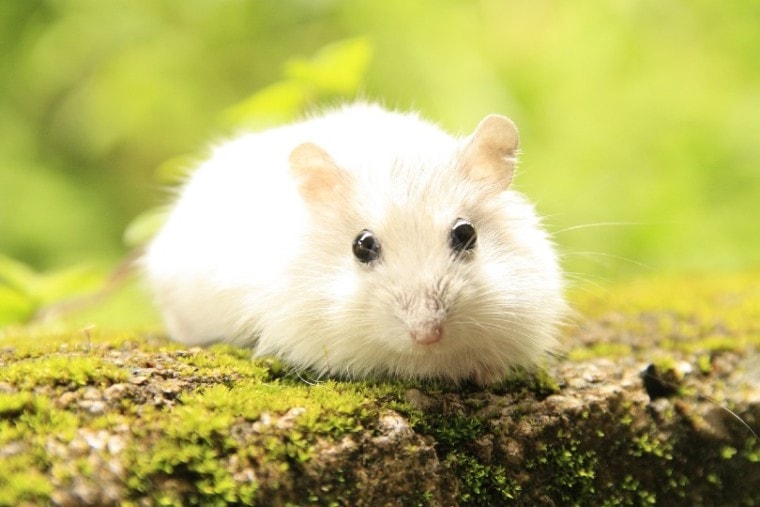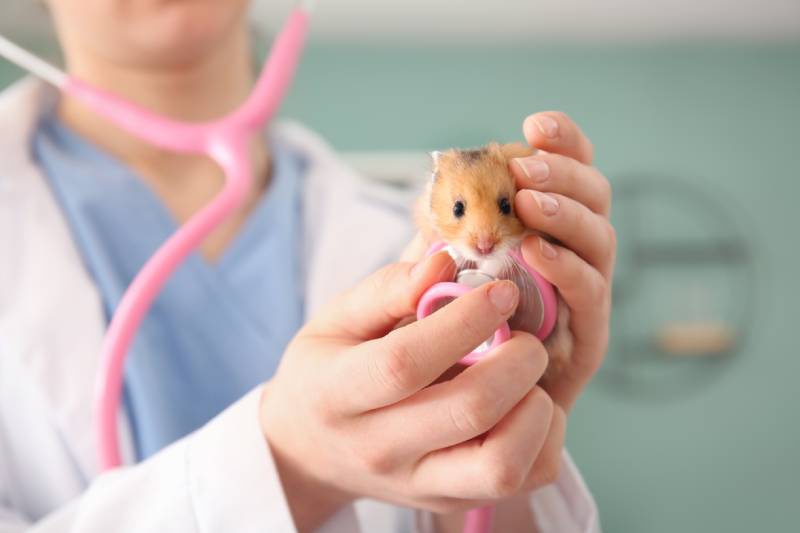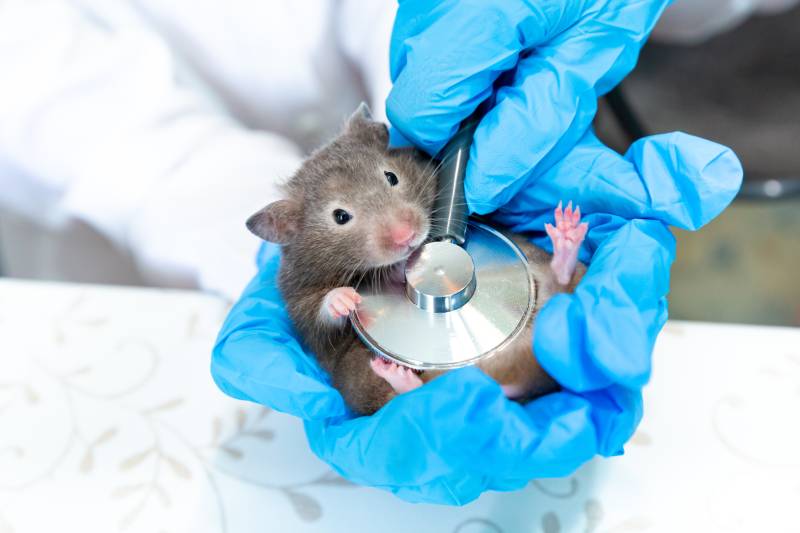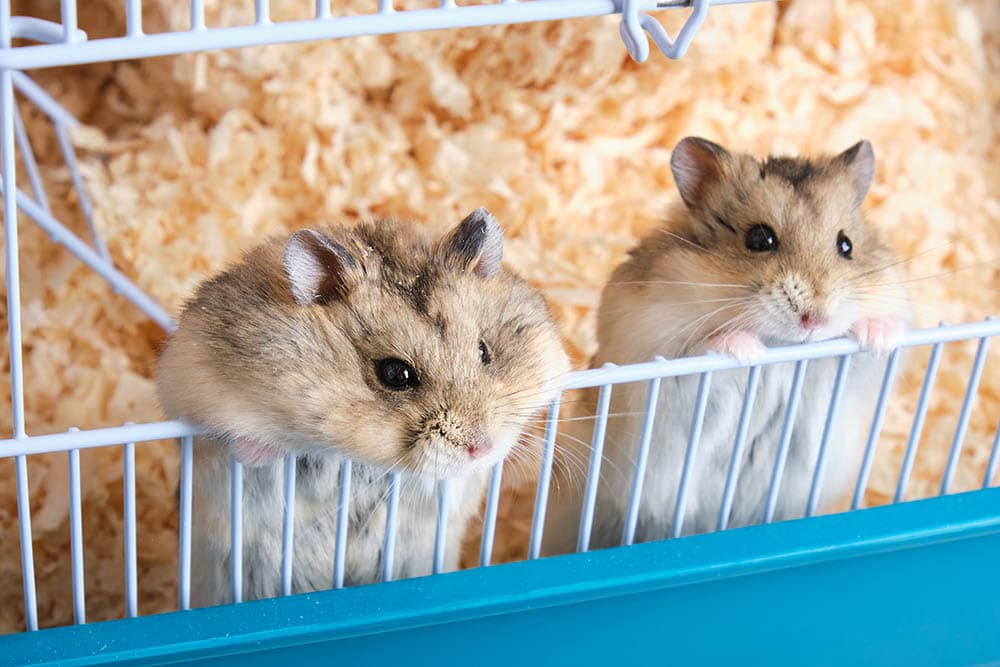
Hamsters are typically children’s pets without many health issues, especially when given proper care. However, medical problems are nearly unavoidable for any animal, including hamsters. In this article, you’ll learn about the common diseases and disorders in hamsters and ways to prevent and treat them where possible.
The 10 Common Diseases in Hamsters
1. Wet Tail
| Type of Health Problem: | Digestive |
| Treatment: | Medications, fluids |
Wet tail is the common name for a serious bacterial infection that mainly impacts young hamsters between 3 and 10 weeks old. Stress is a significant risk factor for developing this disease, including overcrowded living conditions, diet changes, or transport. For example, you may see wet tail in young hamsters just purchased as pets.
Diarrhea is the main symptom of this condition, leading to the characteristic wet fur around the tail and stomach. Decreased appetite and activity levels, as well as weight loss, are other common signs. Treatment will be needed by a veterinarian and generally includes giving fluids to keep the hamster hydrated and antibiotics. Unfortunately, this disease is often fatal.
2. Congestive Heart Failure
| Type of Health Problem: | Heart |
| Treatment: | None |
Older hamsters may develop congestive heart failure, a condition where the heart muscle gets weaker and stops working effectively. This condition can also lead to the development of clots within the hamster’s heart.
Syrian hamsters are especially prone to developing heart failure, around 70% of aged hamsters. Symptoms include fast breathing, bluish skin and gums, and an abnormal heartbeat. Unfortunately, there is no treatment for heart failure in hamsters, but it can sometimes be managed for a short time.

3. Amyloidosis
| Type of Health Problem: | Affects multiple organs |
| Treatment: | Fluids |
In this condition, the hamster’s body overproduces a protein called amyloid, which builds up in various organs over time. Eventually, the protein build-up causes the organs to stop working correctly. For example, amyloidosis is sometimes the cause of heart failure in hamsters. It can also cause kidney and liver failure.
Generally, this disease causes no symptoms until the organs are impacted. It occurs most commonly in female hamsters and typically affects those over a year old or with other long-term health problems. There is no treatment or cure for this condition other than giving fluids or other care to treat the symptoms and keep the hamster comfortable.
4. Constipation
| Type of Health Problem: | Digestive |
| Treatment: | Medications, fluids, surgery, diet change |
Hamsters can become constipated for various reasons. Intestinal parasites are one common cause, as well as eating their bedding. Improper diet and not drinking enough water can also contribute. A more severe cause of constipation is the development of intussusception, when the hamster’s intestines telescope in on themselves.
This medical emergency requires surgery, although even that is often not enough to save the hamster. Other causes of constipation may be treated with diet changes, fluids, or medications. The most obvious symptom is straining to poop, but you may also notice weight loss and decreased appetite.

5. Overgrown Teeth
| Type of Health Problem: | Dental |
| Treatment: | Teeth trim |
Unlike human teeth, the big front chompers of the hamster are constantly growing. Regular chewing and gnawing motions usually keep them from getting too long, but exceptions exist. Hamsters who aren’t provided with chew objects may not be able to wear their teeth down normally. Injuries, structural issues, or dental disease can also impact how the teeth fit together and make it hard to keep the growth under control.
If the hamster’s teeth grow too long, it can be quite painful and keep them from eating normally. You may notice symptoms like drooling, loss of appetite, pawing at the face, and mouth bleeding. To treat this disorder, a vet will need to trim off the excess tooth.
6. Internal Parasites
| Type of Health Problem: | Digestive |
| Treatment: | Deworming medication, cleaning |
Hamsters are commonly infected with two types of internal parasites: pinworms and tapeworms. Both of these can be transmitted to humans, and infected hamsters often show no symptoms. As a precaution, always wash your hands after handling a hamster or cleaning their cage. As we discussed earlier, a severe tapeworm infection can cause constipation and intestinal blockage.
Weight loss, licking at the rear, and decreased appetite are all possible signs of worms. Your vet will confirm a diagnosis by checking a poop sample under the microscope for parasite eggs. Treatment includes dosing the hamster with deworming medication and thorough cleaning and disinfection of the cage to kill any eggs in the environment.

7. Hair Loss
| Type of Health Problem: | Skin and coat |
| Treatment: | Medications, lifestyle changes, diet changes |
Hamsters often suffer from hair loss, which can be the result of a variety of conditions. Skin mites can cause the hamster to scratch away chunks of hair. Cage mates sometimes chew off each other’s hair, or a hamster may rub off its coat on the bars of the cage.
Some hamsters lose hair due to a low-protein diet or hormonal disease. Besides hair loss, you may notice the hamster scratching. Treatment depends on the cause of hair loss. Medication is used to treat skin mites. Diet and lifestyle changes, such as separating hamsters and providing more enrichment, are also often necessary.
8. Polycystic Disease
| Type of Health Problem: | Multiple organs |
| Treatment: | Surgery |
Hamsters with this condition develop fluid-filled sacs or cysts in internal organs, usually the liver. These cysts can grow large enough to burst and cause serious illness. Hamsters over a year old are most commonly impacted.
Symptoms include belly pain, decreased appetite, weight loss, and hair loss. The only treatment for polycystic disease is the surgical removal of the cysts, which is generally only possible when they are located in a female hamster’s ovaries or uterus. If not, the only solution is to keep the hamster as comfortable as possible.

9. Tumors
| Type of Health Problem: | Locations vary |
| Treatment: | Surgery |
Hamsters are prone to developing tumors, but thankfully, most are non-cancerous. Older hamsters sometimes get lymphoma, which results in tumors of the lymph nodes and spleen. Most growths are related to hormones or some part of the digestive process.
Hamsters can also develop fatty tumors as well as growths in the brain, mammary glands, and uterus. Many tumors can be removed with surgery, especially if they are caught early when still small. Check your hamster for lumps and bumps frequently, especially as they get older.
10. Salmonella
| Type of Health Problem: | Digestive |
| Treatment: | Usually not recommended |
Salmonella is an intestinal infection caused by the Salmonella bacteria; it is not the most common in hamsters, but we include it because of its potential danger to humans. The primary symptom of this disease is diarrhea, which makes it hard to distinguish from other illnesses that aren’t dangerous to humans, like wet tail.
Hamsters can pick up the Salmonella bacteria from contaminated fruits and vegetables or bedding. Other than diarrhea, you may notice weight loss and a swollen belly. Your vet will diagnose this condition based on testing a poop sample. As we mentioned, humans can catch Salmonella from hamsters, which can be life-threatening to kids, the elderly, and those with weakened immune systems. Because of this danger, treating infected hamsters is usually not recommended.

Conclusion
Feeding your hamster a balanced diet and providing a safe, clean habitat with environmental enrichment can help prevent many health issues. Because hamsters are mainly active at night, it can be hard to catch symptoms early unless you are paying careful attention to your pet.
Not all of the 10 diseases and disorders on our list are preventable or treatable, but early detection usually offers the best chance of success in getting your hamster healthy again.
Featured Image Credit: Marcela Arrubla, Pixabay









